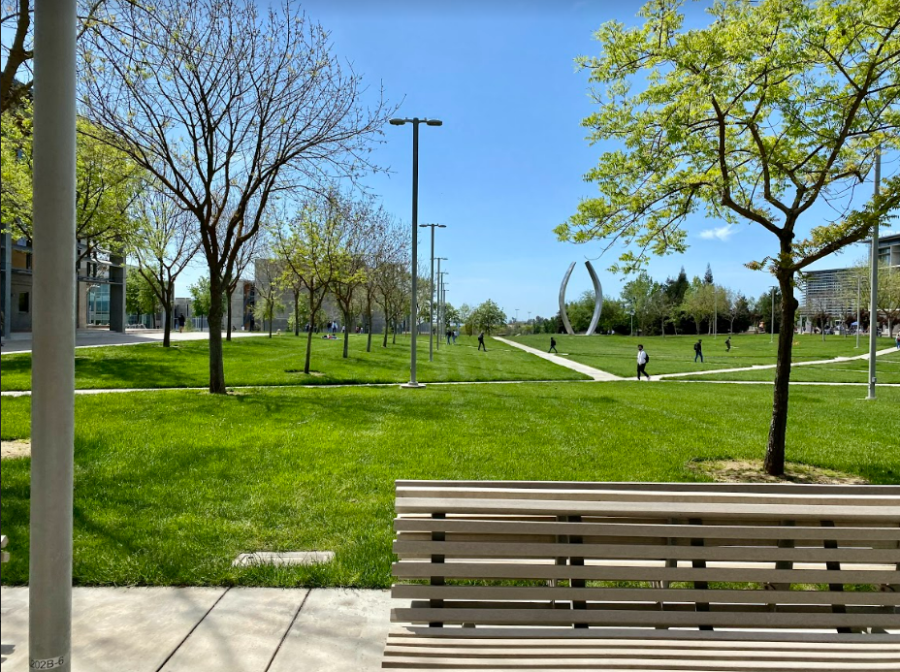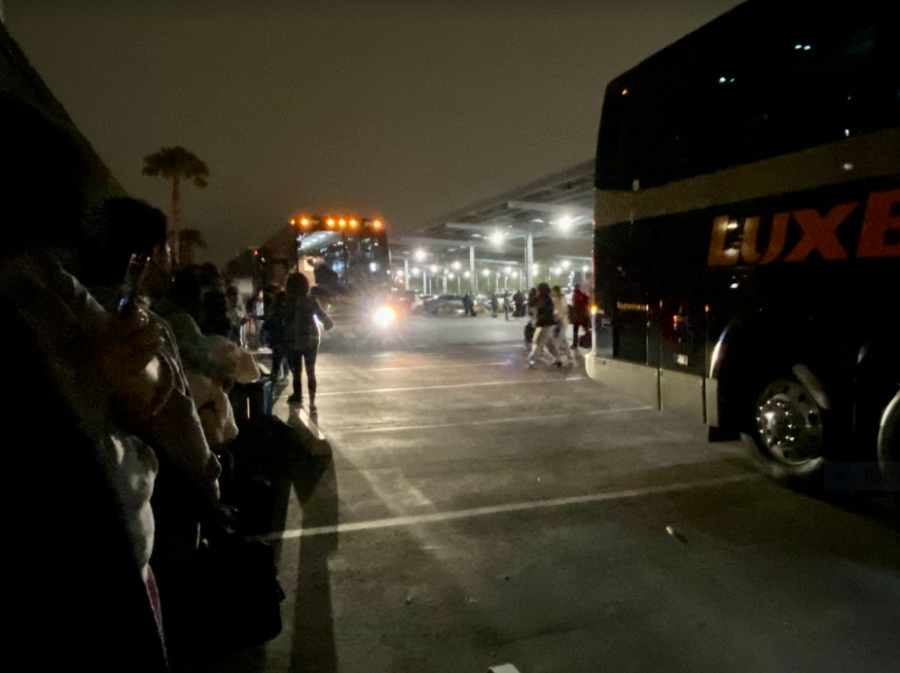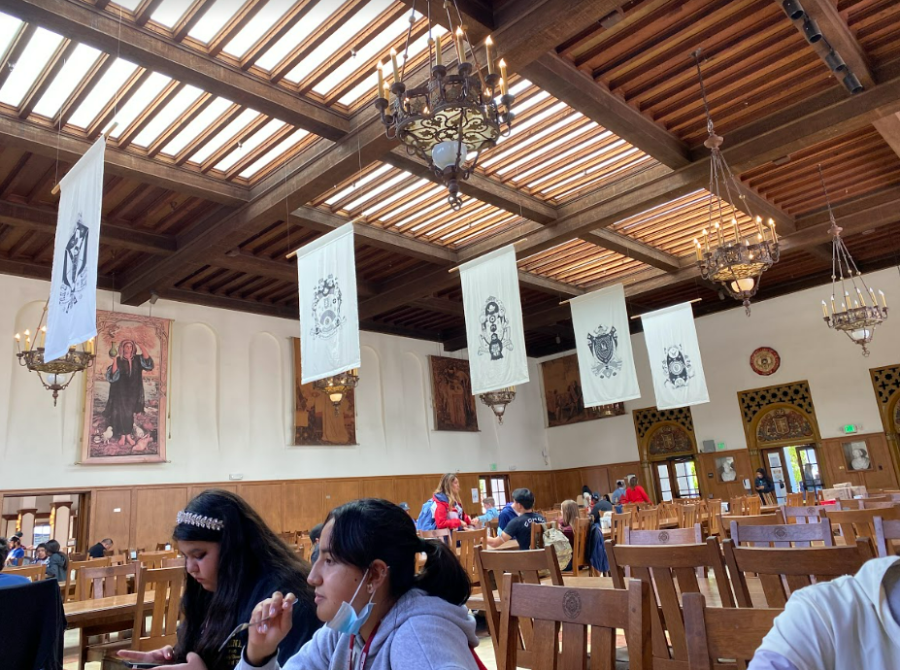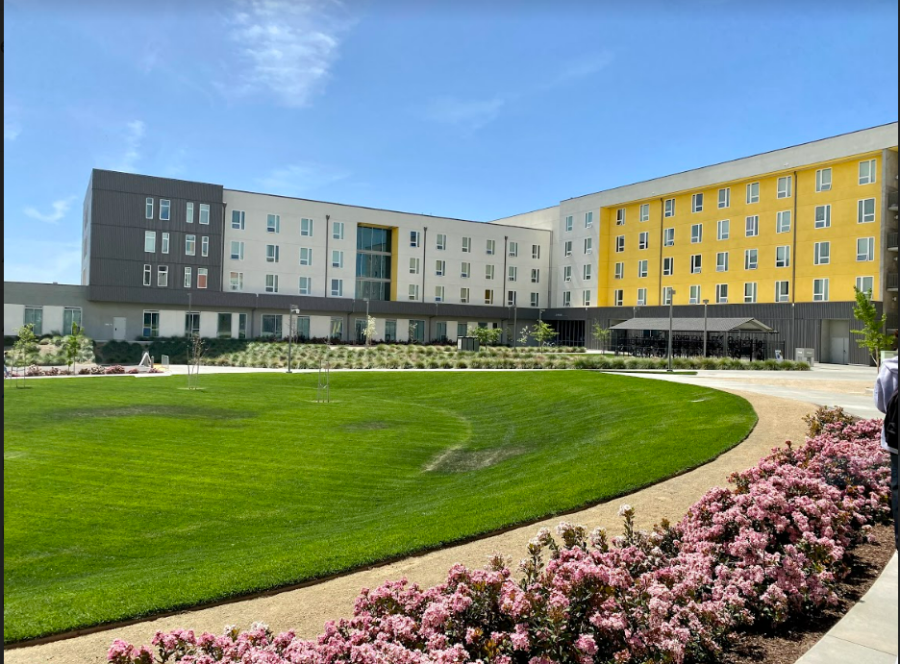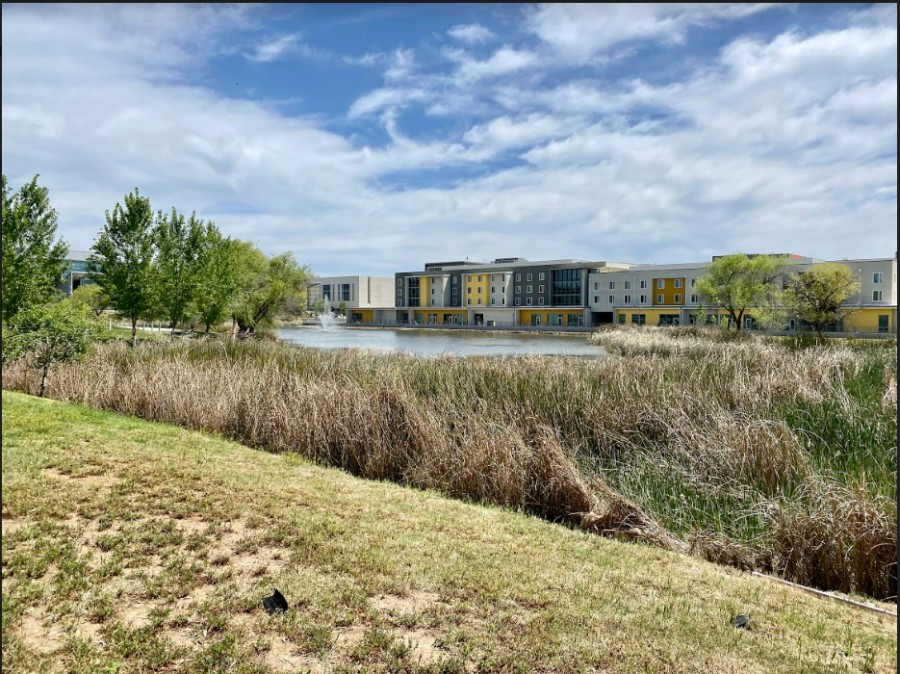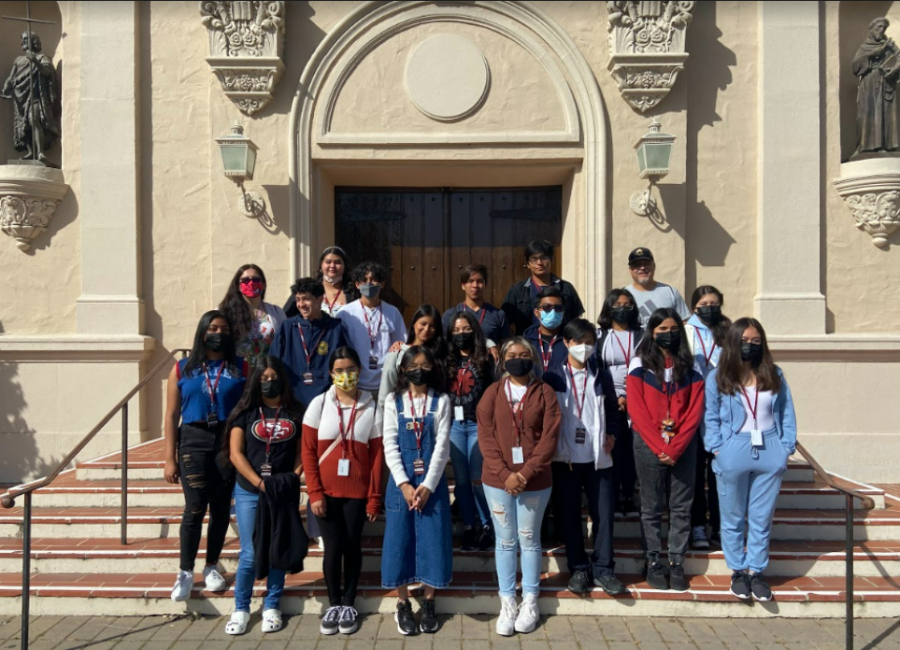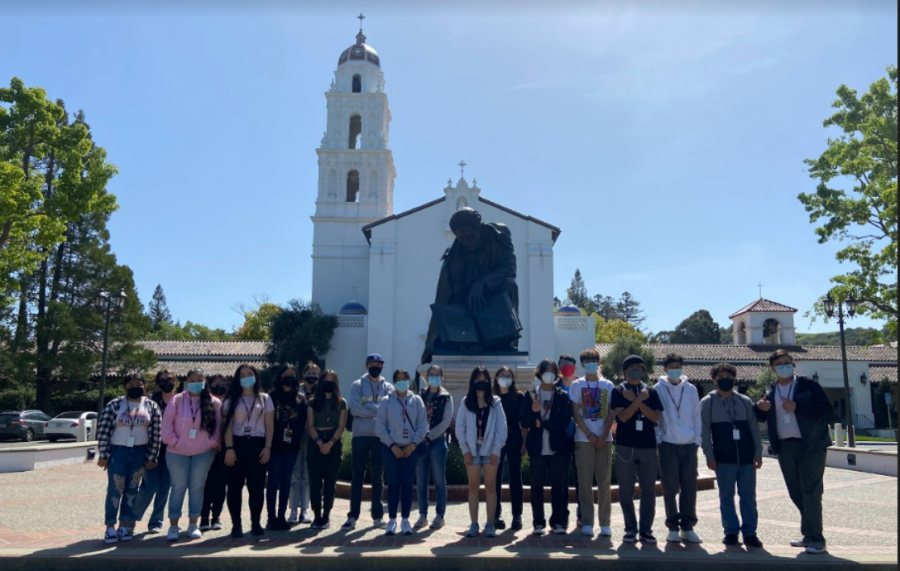40 SAUSD students enter the University of Berkeley through Sather Gate as part of Day 2 of the Spring 2022 College Tours.
SAUSD promotes higher college education through college road trip tours
Where it all started
The wheels cover more miles, students sleep, and a faint sound of music is in the background. Meanwhile, at beautiful higher education institutions, tour guides wait for their possible incoming scholars; their doors are wide open to offer endless opportunities and life changing transformations.
In 2019, the Santa Ana Unified School District started a new opportunity to promote higher education for its high school students through college road trip tours. The Higher Education Coordinator at Godinez Fundamental High School, Jimmy Bravo, was one of the first chaperones to get on a bus with high school students and travel to different colleges. Since then, Bravo has chaperoned the tours three other times. The most recent being the “Spring 2022 College tours.”
My Experience
I first found out about the opportunity through my AVID teacher, Mrs. Peterson, and my counselor Mrs. Quinonez. The application process was simple; it consisted of questions regarding my grade, high school, which of the four tours I would like to be in, and the reason why I would like to participate.
After a couple of days, I was notified that I would go on “Spring 2022 College Tour 4” and visit the institutions in its itinerary: UC Merced, UC Davis, UC Berkeley, St. Mary’s College, Santa Clara University, and San Jose State University. The last thing to do before the tour was attend a parent meeting where all the routes, expectations, and responsibilities were explained.
The day of the tour, I woke up at 4:45 a.m. and left home around 5:30 a.m. I arrived right on time; our luggage was placed inside and I boarded the bus. When other students arrived, the chaperones came in and checked our temperature, vaccination card, and identification card. Bravo said, “We had to make sure no one was sick. It’s always safety, it’s the biggest thing. We’re making sure that the students are being taken care of.”
In the following three days, 40 other SAUSD students and I traveled to Northern California. It was an incredible experience; most research about colleges can be done at home but being on a campus and taking it in as you walk is completely different.
The buildings looked massive; they had beautiful architecture, complex designs, and some had brand new technology. There were also college students walking around and we got a sense of what everyday life is like. The tour guides provided their insights and informed us on the extracurricular, emotional, and educational opportunities.
The overall experience gave me a new sense of hope that in the near future, I will be able to attend a college campus.
Students’ Thoughts
Junior Julie Nguyen said, “I was really happy that I got the opportunity to go. I was looking forward to UC Berkeley, Cal State San Jose, and UC Davis. I wanted to see what it’s like in Northern California, to see the environment and to get a feel for it.”
Most research about colleges and their resources, majors, students, staff, etc. can be found online. However, to be able to walk around campus and absorb the surroundings, buildings, and other students is an entirely different feeling.
“When you get on the bus, you’re excited to see the school and to walk on campus. I didn’t realize how much the environment makes you feel at home,” said junior Nora Santoyo.
The Chaperones’ Thoughts
The chaperones themselves had responsibilities to fulfill.
Bravo said, “We have to make sure that we follow the itinerary that’s making sure that we go from point A to B on time.”
The trip was planned for six college tours in three days, so there was no time for delays. I remember waking up at 6 a.m. to get ready, then eating breakfast at 7 a.m., being on the road as early as 8 a.m., and coming to rest at the hotel as late as 7 p.m.
Counselor from Santa Ana High School, Selena Perez-Duran goes into deeper detail about the daily routines.
“We would ensure that the students woke up on time, keep track of the students, and we were open to talk about the system, tuition, housing, or any questions that came along, and every night we did a reflection activity to process what it was like on campus.”
“I enjoyed the icebreakers and seeing the students get to know each other. For them, it was a learning experience on how to make relationships from day one,” said Angela Bahena, counselor from Cesar Chavez High School.
Counselor from Santa Ana High School, Jacqueline Rodrigues said, “I really loved Santa Clara. I haven’t seen that university before and I was impressed with the programs and the amount of resources that were available. It was an eye opening experience.”
It was a learning experience for everyone on the tour, from the buildings to the financial aid available.
“Seeing students’ excitement of being on campus was memorable; many hadn’t been on that campus, or any in general,” said Perez.
Minorities get support for college through this program
Santa Ana High School is the biggest high school in the district with 3,323 students; it’s composed of 90% students who are economically disadvantaged and 98% who are Hispanic. This results in the total minority enrollment to be 100%.
“Many students don’t have the opportunities to visit these campuses, especially up North, because their parents don’t have these resources,” said Bravo.
Perez further elaborates when she said, “To travel to these schools can be a challenge for our families. Where parents can’t take time off to visit these campuses.”
Low income families must dedicate most of their time to work in order to support their families with basic necessities. Oftentimes, this leaves little support to their children in their educational journey. Due to the large number of first generation students in Santa Ana, many have no one to look up to or ask information about college and how to apply.
Santoyo said, “They’re so used to no one in my family doing college and they’re so used to giving up, they sort of accept not everyone doing well in school. It’s sort of been normalized not to go to a university or career.”
However, views about attending college are changing.
The National Library of Medicine says, “College expectations of Hispanic students doubled from 24 percent in 1972 to 50 percent in 1992; actual college enrollment for Hispanics has increased, as it has for other racial/ethnic groups (U.S. Department of Education, 1995b). In 1972, over 14 percent of Hispanic high school graduates matriculated to four-year colleges (Olivas, 1979); by 2000, 36 percent of Hispanic graduates were enrolled in four-year colleges (U.S. Department of Education, 2003d).”
More Hispanic students are being encouraged to pursue higher education, as a result.
Purpose of the Tour
The tours offer so many elements that will enhance our college exploration and experience.
“They get to learn about the school, programs, what resources to take advantage of, and envision themselves there,” said Bahena.
Walking on campus made all of us feel like college students attending those schools. This allowed us to take in the atmosphere of the location.
Rodrigues said, “The tour is the only way to see what they [the institutions] offer. You won’t necessarily know until you visit it or speak to different representatives.”
While we were going to different colleges, we got to receive and ask questions to the students attending those schools. All the students discussed their application process, classes, majors, tips, opportunities, etc.
“To be inclusive not exclusive. Students are kind of getting along with others. It’s for them to form relationships and develop social skills,” said Bravo.
Throughout the trip, we were encouraged to talk to other students from different high schools. When we were walking, we walked in groups of four or more. Also, when we went to the hotels, we had to sleep in rooms of four which felt like a dorm experience. Not to mention, we got a feel of how competitive the schools are.
“The problem is not low aspirations but mismatches among students’ visions of their future, the courses they take in school, and the information they and their families receive about how to prepare for higher education and employment (Carnevale, 1999).”
The tours perfectly capture what college life will be like, what programs or classes to take, what are some ways that we can deal with the cost, and it helps introduce the idea of being far away from home and our families.
Words of Encouragement
“Don’t let them define who you are, we are all worthy of where we are. First year is difficult for high achieving students who go to prestigious schools. The competitiveness is hard, the stakes are high,” said Rodrigues.
First generation students are more likely to experience some form of imposter syndrome, where one doubts their achievement. However, Rodrigues tries to oppose these intrusive thoughts.
On the other hand, Perez said, “Asking goes a long way, there is nothing to be shy about when it comes to your future.”
The college tours were a great way to communicate our concerns and gather information about the different schools that we would like to attend.
Lastly, Bravo said, “We are still minorities in those institutions. In order for us to thrive, in the U.S. we need to educate ourselves properly, so we can overcome a lot of the hardships that you’ll experience in society. The more educated you are, the more likely you are to thrive. There’s a lot of opportunities in Santa Ana and students need to take advantage and take the value of it.”
